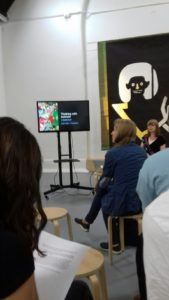 So to a fascinating talk on a Saturday afternoon at Studio Voltaire by Dr Danielle Sands*, Lecturer in Comparative Literature and Thought at the Royal Holloway, University of London.
So to a fascinating talk on a Saturday afternoon at Studio Voltaire by Dr Danielle Sands*, Lecturer in Comparative Literature and Thought at the Royal Holloway, University of London.
Entitled Thinking with Animals, she talked us through the current thinking on animal human relationships and how it developed. From anthropocentric Western humanism, based on the philosophical idea of animals as machines (Descartes) and the primacy of the Human over all other living beings for various reasons – ability to reason, chosen by God etc. – and the binary nature of these schools of thought, either animal or human. Darwin, of course, disputed the binary view saying the differences were ‘in degree not kind’, a view wh ich fits neatly with the theory of evolution. Thence to Derrida The Animal That Therefore I Am questioning the nature of consciousness and to modern thinkers and artists like Saeed who, using advances in science and technology, see humans as animals upon a spectrum of existence. After all, we now know that the human genome is 99.6% chimpanzee.
ich fits neatly with the theory of evolution. Thence to Derrida The Animal That Therefore I Am questioning the nature of consciousness and to modern thinkers and artists like Saeed who, using advances in science and technology, see humans as animals upon a spectrum of existence. After all, we now know that the human genome is 99.6% chimpanzee.
Non-Western cultures have different perspectives – the North American Indian beliefs in the agency of nature, not just animals but also natural forces; the shamanist ‘shapeshifting’ tradition in many cultures; the Buddhist view that we can be reincarnated as either animal or human and may have been so in previous lives; the ancient Greek idea of fluidity between genders and forms. She also touched on modern writer Tom Regan’s ideas, of every living thing as being the ‘subject of a life’. There are challenges to humanism, not just those of 19th century thinkers like Marx, Nietzsche and Freud, but the ideas of transhumanism ( technologically adapted humans, their genes spliced to eradicate disease, their bodies augmented ), but also in response to the idea of the Anthropocene, the latest, controversial categorisation of geo-biological time.
This provided context for the works which surrounded us, by Lin Mae Saeed ( see Lin Mae Saeed – Biene ) which directly  addressed humanity’s relations with animals, characterising them as companions, votives, an exploited labour force or food source and by extension, questions our impact on and interactions with the environment. Ethics and morality are, necessarily, also part of this debate.
addressed humanity’s relations with animals, characterising them as companions, votives, an exploited labour force or food source and by extension, questions our impact on and interactions with the environment. Ethics and morality are, necessarily, also part of this debate.
Sands is particularly interested in the interrelationships between philosophical aesthetics, critical theory and literary studies. The animal as the ‘first metaphor’ (John Berger), the control of the narrative (Anna Tsing) and the need to develop a new way of considering what art might be. Can art allow a cross species empathy? Does literature allow us to imagine our way into an animal’s existence? We considered J.M Coetzee’s Elizabeth Costello (2003) but, interestingly, Dr Sands was of the opinion that in this area of thought fiction was behind theory. So there was no accessible novel, fantasy, sci-fi or literary which illuminated these debates like, for example, Le  Guin’s The Left Hand of Darkness did for debates about gender.
Guin’s The Left Hand of Darkness did for debates about gender.
Fascinating stuff.
Sands’ first monograph, ‘Animals, Plants, Things: Nonhuman Storytelling between Philosophy and Literature’ is forthcoming with Edinburgh University Press, though there is no publication date as yet.
*She received a British Academy Rising Star Engagement Award 2018 for the project ‘Posthumanities: Redefining Humanities for the Fourth Industrial Age’, and she is currently leading the TECHNE Conflux ‘How Like a Leaf: Art, Nature, World’ (2018-20).
For more on art and thought try Vittorio Scarpati & Cookie Mueller Welcome to Saxnot Conversation at the Horse Hospital Rachel Whiteread


 RSS – Posts
RSS – Posts
One response to “The Post-human World”